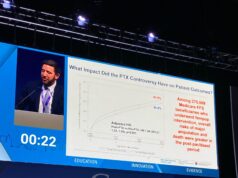
A new paper looking specifically at mortality has found no difference in deaths between paclitaxel-coated balloons and uncoated balloons when used in the femoropopliteal artery. These data, a pooled analysis of four randomised controlled, multicentre trials, were published in Cardiovascular Interventional Radiology.
In light of the recent meta-analysis by Konstantinos Katsanos (Patras University Hospital, Rion, Greece) et al—writing in the Journal of the American Heart Association (JAHA)—reporting significantly increased mortality at two and five years following angioplasty with paclitaxel-coated devices in peripheral arteries, Thomas Albrecht (Vivantes Klinikum Neukölln, Berlin, Germany) and colleagues performed a two-year, patient-level mortality analysis based on pooled, original data of four randomised, controlled trials (RCTs): THUNDER, FEMPAC, PACIFIER and CONSEQUENT.
This study included 185 patients in the control group (plain angioplasty), and 184 patients in the paclitaxel-coated balloon group, followed up to two years. At two-year follow-up, 13 of 185 patients had died in the control group and 16 of 184 in the paclitaxel-coated balloon group. Corresponding mortality rates were 7% and 8.7% of available patients, respectively (p=0.55). Kaplan–Meier statistics for freedom from all-cause death also showed no difference between groups (p=0.54).
“All this is new, important patient-level data contradicting the paper of Katsanos,” Albrecht tells Interventional News.
Causes of death similar between paclitaxel-coated balloon arm and control arm
Causes of death were split into cardiac (heart failure, acute myocardial infarction, cardiac arrhythmia, and sudden cardiac death), malignancy (of the liver, pancreas and lung), sepsis (pneumonia and perforated duodenal ulcer and peritonitis), and other (which includes chronic obstructive pulmonary disease). The most common causes were cardiac, responsible for the deaths of six patients in the control group and four after paclitaxel-coated balloon use, and malignancy: one lung cancer and one liver cancer in the control group, and one lung cancer and two pancreatic cancers in the paclitaxel-coated balloon group. Causes of death only seen in the paclitaxel-coated balloon group were stroke, major amputation, thrombosis, multiple organ failure, brain haemorrhage and trauma (one patient each). “Overall, causes of death were well balanced between the treatment groups with no obvious pattern or trend towards an increase in any specific causes of death in the paclitaxel-coated balloon group”, write Albrecht et al.
“Even if one assumed that these deaths might have been influenced by the use of paclitaxel-coated devices,” they muse, “it would be extremely difficult to explain what common toxicological mechanism might have played a role in such very different diseases, especially if one considers the extremely low doses of paclitaxel on paclitaxel-coated balloons.”
Study finds no association between paclitaxel dose and increased mortality
Patients who underwent paclitaxel-coated balloon angioplasty and died during the 24-month follow-up did not have a higher paclitaxel dose compared to those who did not die. Indeed, the mean dose per patient was numerically lower in patients who died. The mean delivered paclitaxel doses were 5.3±4.224µg in patients that died during the two-year follow-up, and 6.248±4.629µg in those who did not die (p=0.433).
Speaking of the JAHA meta-analysis findings, Albrecht and colleagues say that Katsanos et al’s “postulated causality was on the foundation of theoretically-derived paclitaxel doses, which in turn were based on a number of assumptions.” According to Albrecht et al, these assumptions included the lesion length and vessel diameter representing the exposed tissue surface, irrespective of the used drug delivery platform (stent or balloon). Conversely, Albrecht et al based their calculation of paclitaxel dose on measurements of residual paclitaxel left on the balloons catheters after use in every patient.
Whilst paclitaxel dosage was not found to be associated with increased mortality, a patient age of 75 years or more was. This was the only significantly associated risk factor for two-year mortality observed by Albrecht and colleagues. They report that all other tested patient and lesion variables had no significant association with mortality. Treatment groups—uncoated balloon or paclitaxel-coated balloon—were not a predictor for mortality (p=0.53) in this analysis.
Armed with these results, Albrecht and colleagues conclude: “We could therefore not confirm the findings of significantly increased mortality after paclitaxel-coated devices in the recent meta-analysis by Katsanos et al.”
Perceived limitations of the Katsanos et al meta-analysis
This present study was designed to overcome several objections Albrecht and colleagues have to the methodology used by Katsanos and team.
Albrecht et al write: “One inherent limitation of the meta-analysis by Katsanos et al is the lack of access to original patient data. Instead, published summaries of data were used. None of these publications focused on mortality, and neither was mortality the primary endpoint of the included studies, nor were the studies designed or powered for long-term analysis of mortality. (Primary endpoints were usually late lumen loss or patency at six or 12 months.)”.
They continue: “Furthermore, for several included studies, the mortality data used in the meta-analysis were calculated based on the number of originally included patients and not on the number of patients with follow-up which was available at the relevant time points. In other words, patients lost to follow-up could not be appropriately considered. Last but not least, causes of deaths were not available to Katsanos and colleagues for most included studies, so that they could not provide any causative explanation, as to why more patients might have died after the use of paclitaxel-coated devices and what the underlying toxicological mechanism might be.
“These limitations potentially challenge the results of Katsanos et al, and the authors acknowledge the urgent need for further investigation into the subject”. This last comment references one of the closing remarks of the JAHA paper, where the authors conclude that “Further investigations are urgently warranted”.













